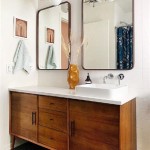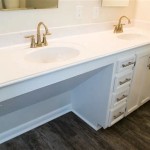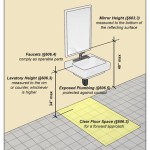16 Square Bathroom Sinks: A Comprehensive Guide
Square bathroom sinks have surged in popularity, offering a contemporary and geometric aesthetic that complements a wide range of bathroom styles. Their clean lines and angular forms provide a refreshing alternative to traditional round or oval sinks, injecting a touch of modern sophistication into the space. This article delves into the diverse world of square bathroom sinks, exploring their various types, materials, installation methods, design considerations, and maintenance aspects. This guide aims to provide comprehensive information for individuals considering incorporating a square sink into their bathroom renovation or construction project.
The appeal of square sinks lies in their ability to create a focal point while maintaining a sense of order and balance within the bathroom. The sharp edges and distinct geometry can visually enhance the space, creating a feeling of spaciousness and organization. Whether integrated into a minimalist, modern, or even a transitional design scheme, a square sink can seamlessly blend in or intentionally stand out, depending on the chosen style and finishes.
Selecting the right square bathroom sink requires careful consideration of several factors, including the overall bathroom design, available space, plumbing configuration, and personal preferences. A comprehensive understanding of the different types, materials, and installation options is crucial for making an informed decision that aligns with both functional and aesthetic requirements.
Types of Square Bathroom Sinks
Square bathroom sinks are available in a variety of mounting styles, each offering distinct aesthetic and functional characteristics. Understanding these differences is crucial for selecting the most suitable option for a particular bathroom layout and design.
1. Undermount Sinks: These sinks are installed beneath the countertop, creating a seamless transition between the sink basin and the surrounding surface. Undermount sinks offer a clean, streamlined appearance and are particularly well-suited for countertops made of solid materials like granite, quartz, or marble. The absence of a visible rim makes cleaning easier, preventing the accumulation of dirt and grime. The undermounted design also maximizes countertop space, providing a larger usable surface area.
2. Vessel Sinks: Vessel sinks, also known as above-counter sinks, sit directly on top of the countertop, resembling a decorative bowl. They are often chosen for their striking visual impact and can serve as a focal point in the bathroom design. Vessel sinks come in a wide range of materials, colors, and finishes, allowing for significant customization. However, they typically require a taller faucet to accommodate the increased height of the sink. The raised profile also requires more care to avoid splashing during use, and cleaning around the base where it meets the countertop can be more challenging.
3. Drop-in Sinks: Also known as self-rimming sinks, drop-in sinks are installed into a pre-cut hole in the countertop. A rim or lip on the sink’s edge rests on the countertop surface, providing support. Drop-in sinks are relatively easy to install and are compatible with a variety of countertop materials. They are a versatile option that can be used in various bathroom styles. However, the visible rim can collect dirt and grime, requiring more frequent cleaning. The rim also reduces the usable countertop space around the sink.
4. Wall-mounted Sinks: Wall-mounted sinks are attached directly to the wall, eliminating the need for a countertop or vanity. This type of sink is ideal for smaller bathrooms or powder rooms where space is limited. Wall-mounted sinks create a minimalist and contemporary look, and they offer the advantage of adjustable height for added accessibility. However, the plumbing is exposed and requires careful consideration to ensure an aesthetically pleasing installation. Adequate wall reinforcement is also necessary to support the weight of the sink and its contents.
5. Console Sinks: Console sinks combine a wall-mounted sink basin with supporting legs, creating a hybrid of wall-mounted and freestanding designs. They offer a vintage or traditional aesthetic while providing some level of storage space beneath the sink. Console sinks typically feature open shelving or a small cabinet for storing toiletries and other bathroom essentials. They are a good option for bathrooms where both style and functionality are desired. Installation requires both wall mounting and leg support, ensuring stability and proper weight distribution.
Materials Used in Square Bathroom Sinks
The material of a square bathroom sink plays a significant role in its appearance, durability, and maintenance requirements. Different materials offer varying levels of resistance to scratches, stains, and impacts. The most common materials used for square bathroom sinks include:
1. Porcelain: Porcelain is a classic and widely used material for bathroom sinks. It is durable, non-porous, and resistant to stains and scratches. Porcelain sinks are easy to clean and maintain, making them a practical choice for high-traffic bathrooms. They are typically available in a limited range of colors, primarily white and off-white. However, the simplicity of porcelain can complement a variety of design styles.
2. Ceramic: Ceramic is similar to porcelain but is generally less dense and durable. Ceramic sinks are more susceptible to chipping and staining compared to porcelain. However, they are often more affordable and are available in a wider range of colors and designs. Ceramic sinks require regular cleaning to prevent the build-up of dirt and grime. The less dense nature of ceramic means it is more prone to water absorption, potentially leading to cracking over time.
3. Stone: Stone sinks, such as granite, marble, and travertine, offer a luxurious and natural aesthetic. Each stone sink is unique, with variations in color, veining, and texture. Stone sinks are durable and resistant to heat, but they can be porous and require sealing to prevent staining. Regular cleaning and maintenance are essential to preserve the beauty and integrity of stone sinks. The weight of stone sinks often requires additional support during installation.
4. Glass: Glass sinks are a modern and stylish option that adds a touch of elegance to any bathroom. They are available in a variety of colors, shapes, and textures. Glass sinks are non-porous and resistant to stains, but they can be susceptible to scratches and chips. Special care is required when cleaning glass sinks to avoid damaging the surface. The translucent nature of glass can also make water spots and mineral deposits more visible, requiring frequent cleaning.
5. Stainless Steel: Stainless steel sinks are durable, hygienic, and resistant to corrosion. They are a popular choice for modern and industrial-style bathrooms. Stainless steel sinks are easy to clean and maintain, but they can be prone to scratches and water spots. The metallic finish can also be quite reflective, which may not be desirable in all bathroom settings. The sound of running water can also be amplified in stainless steel sinks.
6. Concrete: Concrete sinks offer a unique and industrial aesthetic. They are durable and can be customized with various colors and finishes. Concrete sinks require sealing to prevent staining and water absorption. The porous nature of concrete means it is susceptible to cracking if not properly maintained. The weight of concrete sinks also requires significant structural support during installation.
Design Considerations for Square Bathroom Sinks
When incorporating a square bathroom sink into a bathroom design, several key considerations must be taken into account to ensure a cohesive and functional space.
1. Size and Proportion: The size of the square sink should be proportional to the size of the bathroom and the vanity or countertop it will be installed on. A large sink in a small bathroom can overwhelm the space, while a small sink in a large bathroom may look insignificant. Consider the available space and the desired functionality when determining the appropriate size of the sink.
2. Faucet Selection: The faucet style and placement should complement the square sink's design. Tall faucets are often required for vessel sinks, while shorter faucets are suitable for undermount and drop-in sinks. The faucet finish should also coordinate with the overall bathroom design. A widespread faucet can enhance the geometric lines of the square sink, while a single-hole faucet can create a more minimalist look. The reach and height of the faucet spout should also be considered to prevent splashing and ensure comfortable use.
3. Countertop Material: The countertop material should complement the square sink’s material and color. Solid surface countertops like granite and quartz are ideal for undermount sinks, while laminate and wood countertops can be used with drop-in sinks. Consider the durability, maintenance requirements, and aesthetic appeal of the countertop material when making a selection. The color and pattern of the countertop should also harmonize with the sink and the overall bathroom color scheme.
4. Storage Solutions: Consider storage solutions around the square sink to maximize functionality and organization. Vanities with drawers and cabinets provide ample storage space for toiletries and other bathroom essentials. Open shelving can also be used to display decorative items or store frequently used items. The placement of storage solutions should be carefully considered to ensure easy access and prevent clutter. Integrating wall-mounted cabinets or shelves can also help to maximize vertical space in smaller bathrooms.
5. Lighting: Proper lighting is essential for creating a functional and aesthetically pleasing bathroom. Adequate lighting should be provided around the square sink to ensure visibility and safety. Consider installing sconces on either side of the mirror or vanity light above the sink. The color temperature of the lighting should also be considered to create the desired ambiance. Warm lighting can create a relaxing and inviting atmosphere, while cool lighting can provide a more energizing and functional space.
6. Overall Bathroom Style: The square sink should complement the overall bathroom style. A sleek, modern square sink may not be suitable for a traditional or rustic bathroom. Consider the overall design aesthetic and choose a sink that blends seamlessly with the existing decor. The color, material, and style of the sink should all contribute to the overall cohesive look of the bathroom.

Karran Quattro 16 In Matte White Acrylic Square Vessel Sink Qm178wh The Home Depot

Alfi Brand Abc903 16 Modern Square Above Mount Ceramic Sink

Vigo Hibiscus Modern White Matte Stone 16 In L X W 5 H Square Vessel Bathroom Sink Vg04004 The Home Depot

Swiss Madison Lisse 16 Square Concrete Vessel Bathroom Sink In Dark Grey Com

Square Vessel Ceramic Bathroom Sink White Kraus Usa

Square Vessel 16 1 2 Inch Ceramic Bathroom Sink Kraus Usa

Sinber 16 X 4 92 Square Ceramic Countertop Bathroom Vanity Vessel Sink

Aquaterior 16 Square Bathroom Porcelain Sink W Drain Com

16 Square Porcelain Bathroom Vessel Sink Countertop White Ceramic Wash Basin Com

Lordear Porcelain Vanity Sink White Ceramic Vessel Square Modern Bathroom 16 In X The Sinks Department At Com
Related Posts







